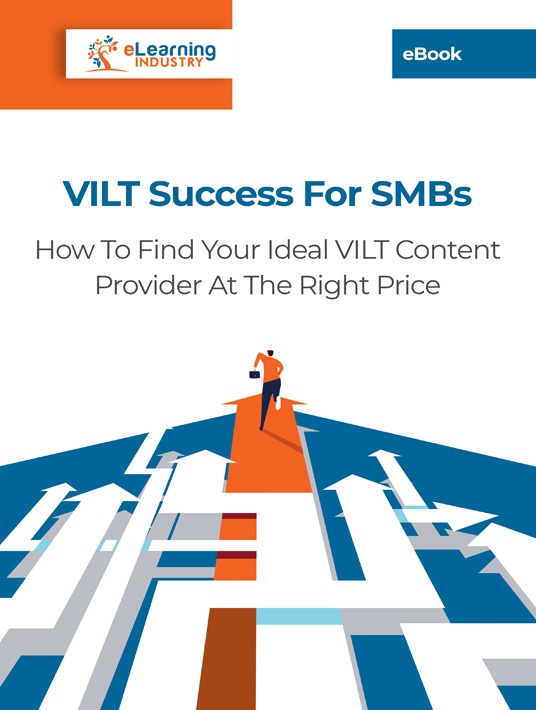How To Evaluate A VILT Vendor's Proposal
The primary goal of RFPs is to get results and round up estimates from your shortlisted vendors to see who makes the cut. But what should you look for in virtual classroom training proposals? More importantly, are there any red flags you should be aware of to avoid buyer’s regret? The evaluation process is often daunting because there’s so much information to comb through, from cost breakdowns to detailed timelines. The secret is to formulate a game plan before the first proposal shows up in your inbox. Implement these 7 tips and techniques for a VILT proposal evaluation and make the best buying decision for your SMB.

1. Schedule Proposal Evaluation Sessions With L&D Outstaffers
L&D and HR staffers, as well as training managers, must be involved in the decision-making process. They’ll work with the VILT company to some extent. Whether it’s collaborating with SMEs to sum up the key takeaways or working with their design team to incorporate your branding. So, schedule a proposal evaluation session to gather their feedback. You can even send it to remote team members and host a web conferencing meet-up to explore all the options.
2. Create A Scoring System
It’s often difficult to quantify proposal evaluations because they involve aesthetics and emotional connectivity. Does the deliverable grab your attention and facilitate knowledge transfer? Does it align with your brand image and boost employee engagement? However, you can develop a scoring system that makes it easier to analyze the data. For example, there’s a scoring scale of 0 to 10. This VILT vendor scored a 5 on industry experience, but a 10/10 on price point. You should also consider their customer service, support, and solutions list when calculating the final score.
3. Draft A Comparison Checklist
You must be able to compare the VILT vendors on an even playing field to analyze cost, development time, and qualifications side by side. In addition to the overall score, create a comparison checklist that delves into the tasks, deliverables, and online training solutions involved. You can even include user ratings, specialization areas, and standout selling points that you should factor into your decision, such as advanced eLearning authoring tools, tech expertise, and innovative VILT strategies.
4. Identify Compromises For Each Vendor
Organizations must often make some compromises when choosing a Virtual Instructor-Led Training provider. It might be that the vendor charges more but offers more industry experience. Or that they have top-notch design skills but limited support services. It’s important to evaluate the pros and cons for each company and how they affect your outsourcing strategy or online training ROI. Does this compromise force you over budget? Could it negatively impact real-world application or knowledge retention for your employee training participants?
5. Rank VILT Vendors' Targeted Skills And Talents
Every VILT vendor has their own USP and professional background. While some excel in IT and can help you produce interactive and immersive VILT experiences, others are known for top-notch sales training and skill-building. Determine which competencies and traits you’re looking for in a vendor. Then rank vendors in each category. For example, you’ve whittled it down to 5 Virtual Instructor-Led Training Companies. One provider clearly outshines the competition when it comes to hand-on application because they offer virtual labs and skills reinforcement. But another candidate has noteworthy instructors who are industry thought leaders and stand out in the cutting-edge tech category.
6. Evaluate The Price Point Versus ROI
Some organizations make the mistake of focusing on the price tag. They don’t consider the complete picture, such as what’s included in the cost and online training ROI. Every vendor includes their fee in VILT proposals, which covers everything from software expenses and development time to SMEs and instructors. Evaluate their price point in terms of online training returns. Which virtual classroom vendor offers the best value for money based on your KPIs and L&D priorities? If the content provider is more expensive, do they bring something unique to the table to make up the difference? It’s also a good idea to evaluate costs in the long term. For example, the plan is to gradually roll out VILT in every department and the vendor is willing to reduce their fee if you contract with them for multiple projects.
7. Devise A List Of Follow-Up Questions
You may need more information to make the best buying decision for your SMB. Create a list of follow-up questions and send them to your top 3 choices. Or, better yet, set up a meeting to discuss their ideas and VILT approach one-on-one. This offers you the opportunity to go beyond what’s written on paper and get a feel for their personality. Are they passionate about online training development and tech? Do they understand your online training objectives and goals? Can they explain how their company will help you achieve the desired results and stretch your budget? The questions keep the conversation on topic so that you don’t forget any crucial evaluation points.
VILT vendors typically invest a significant amount of time and effort in drafting proposals. Thus, you need to consider all the responses carefully, using the same comparison criteria before you complete your VILT proposals evaluation. It’s also safe to say that you might disqualify certain vendors right off the bat. Maybe they’re out of your price range or they lack the necessary experience. However, you should still reach out to let them know they’re out of the running and possibly even discuss your sticking points. In some cases, the VILT provider may work with you to negotiate a better price or clarify their qualifications.
You can discover even more tips on how to choose the right VILT content provider for your business in our eBook VILT Success For SMBs: How To Find Your Ideal VILT Content Provider At The Right Price. Benefit from top VILT vendors’ experience and know-how and reach your online training objectives even if you are on a tight budget.

